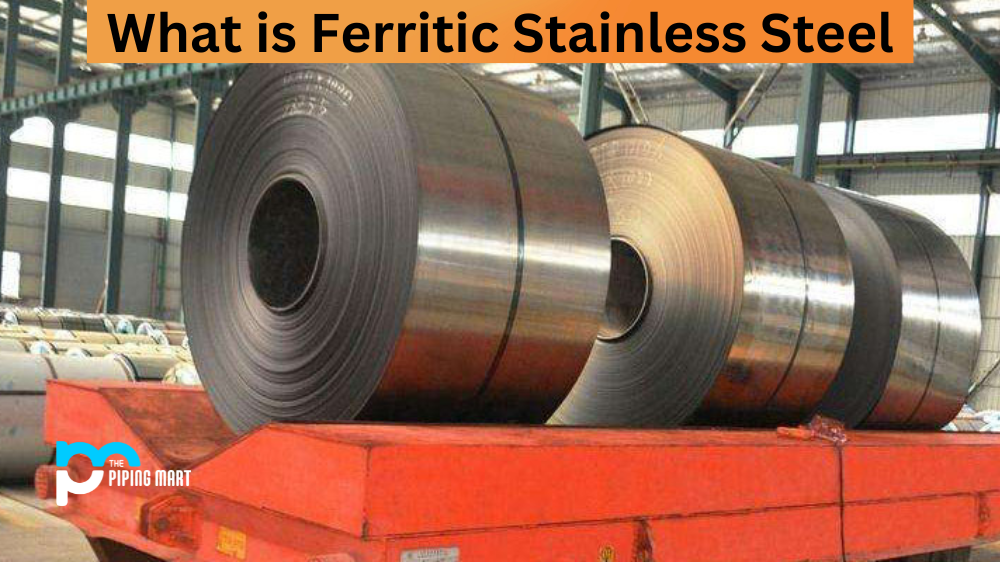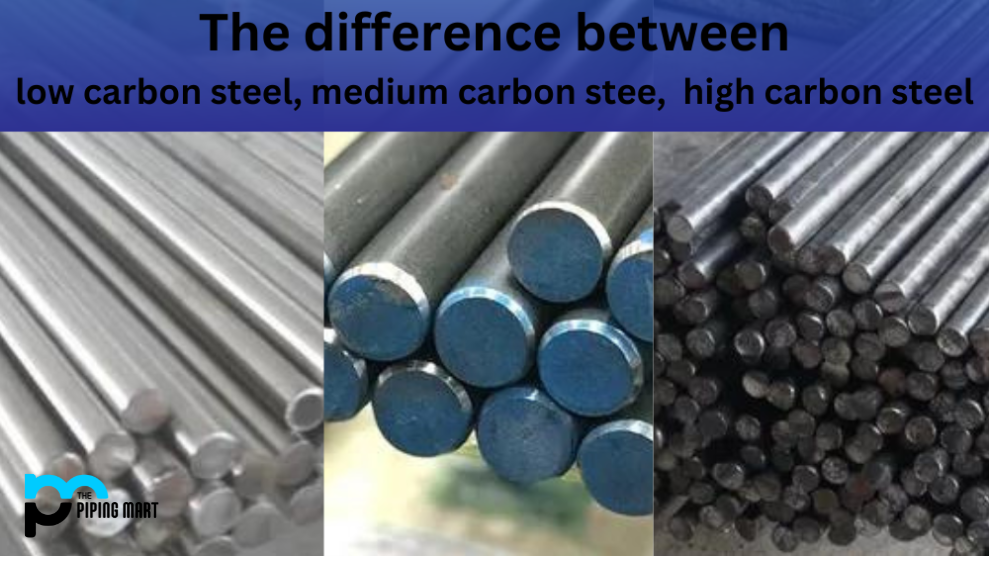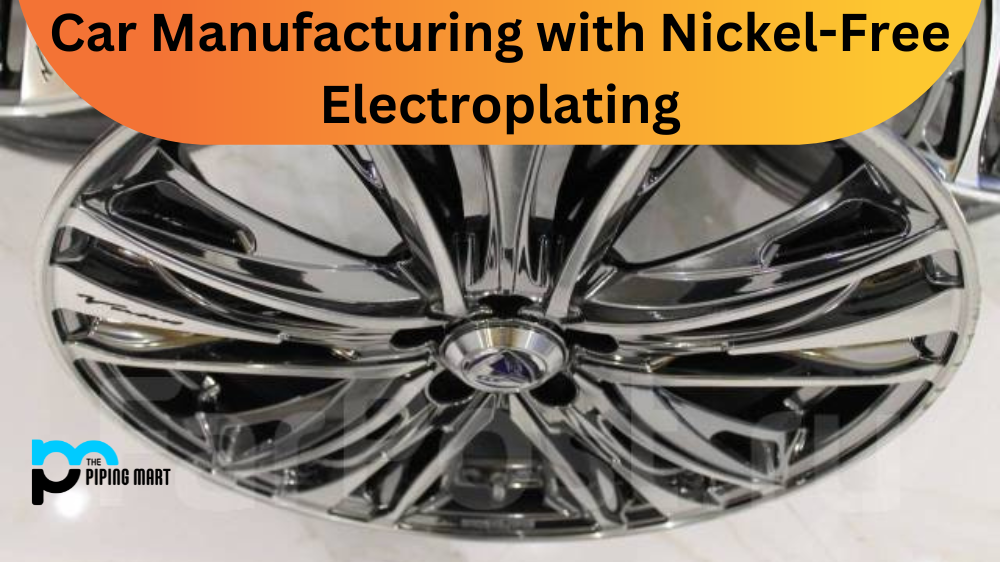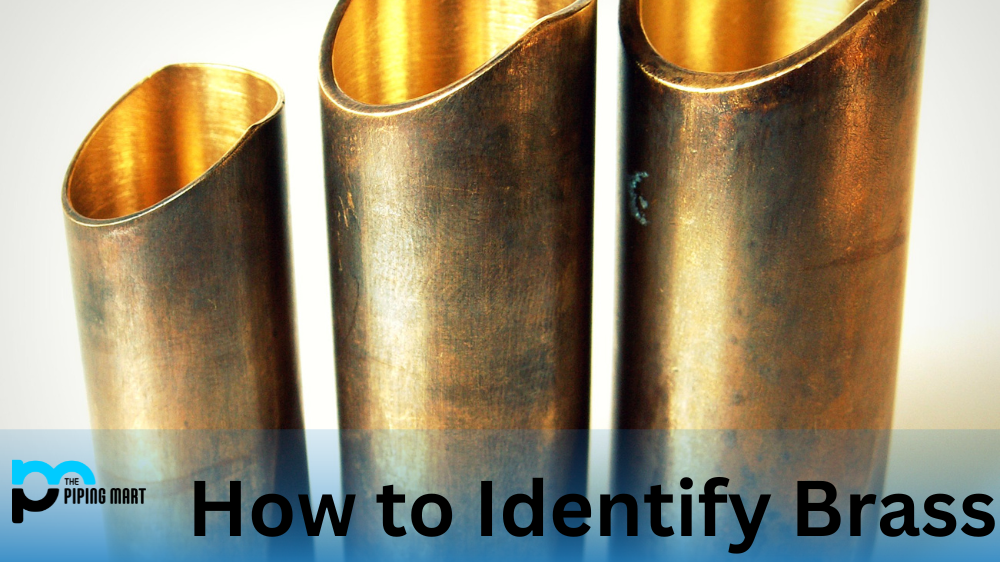Ferritic stainless steel is a type of stainless steel with a ferrite microstructure. It has better corrosion resistance and mechanical properties than plain carbon steel, but it is not as tough or ductile as austenitic stainless steel. In this blog post, we will discuss the properties, uses and chemical composition of ferritic stainless steel.
What is Ferritic Stainless Steel?
Ferritic steels are magnetic, high-chromium stainless steels with little carbon content. Ferritic stainless steels have a body-centered cubic (BCC) lattice structure and are magnetic by nature. They include a lot of chromium (10.5-27% by weight), minimal carbon (0.03-0.12% by weight), and only trace amounts of nickel, manganese, molybdenum, niobium, and titanium. Ferritic steels are frequently used in industrial equipment, kitchenware, and automotive applications due to their excellent ductility, resistance to corrosion, and stress corrosion cracking.
After austenitic stainless steel, ferritic stainless steels are the type of stainless steel used most frequently. They are renowned for their flexibility, corrosion resistance, and magnetic characteristics, and they have high chromium contents but little to no nickel. They can only be cold worked and softened during annealing because they have a body-centered cubic grain structure and cannot be hardened with heat treatment.
Depending on their composition and intended use, ferritic stainless steels are divided into the 400 series, which is then divided into five groups. Even though ferritic stainless steels were created very early, it wasn’t until the 1980s that they began to replace austenitic stainless steels, which were more expensive due to their nickel content.
Ferritic Stainless Steel Chemical Composition
Ferritic stainless steels contain between 10‐20% chromium but do not contain nickel as the austenitic grades do. Some common alloys that are part of the ferritic family are 409L/409Cb (used for automotive exhausts), 430 (used in household appliances), and 439 (used for fuel tanks). These steels contain small amounts of manganese, molybdenum, or titanium for enhanced formability and strength. The addition of nitrogen during production can also improve their performance under high-temperature conditions.
Ferritic Stainless Steel Grades
In general, there are five groups of ferritic stainless steel alloys, three families of normal grades (Groups 1 to 3), and two families of specialty grade steels (Groups 4 and 5). The market for specialty grade stainless steels is gradually rising, even though normal ferritic steels continue to be the largest consumer group in terms of tonnage.
Group 1 (Grades 409/410L):
The least expensive of the five groups is this particular group, which has the lowest chromium concentration of any stainless steel. They work best in situations that are just mildly corrosive and where localized rust is acceptable. Grade 409 is presently used in catalytic converter casings and automobile exhaust tubes after being developed first for automotive exhaust system silencers. Buses, LCD display frames, and containers frequently use grade 410L.
Group 2 (Grade 430):
Group 2 contains the ferritic steels that are most frequently utilized. Because they contain more chromium, they are more resistant to corrosion caused by nitric acid, sulfur dioxide, and many other organic and food acids. These grades can take the place of the austenitic stainless steel grade 304 in various applications. Appliance interiors, such as washing machine drums, kitchen sinks, indoor panels, dishwashers, cutlery, cooking utensils, and food processing machinery, are frequently made of grade 430 steel.
Group 3 (Grades 430Ti, 439, 441, and Others):
Group 3 steel can be utilized to replace austenitic grade 304 in a larger range of applications, including sinks, exchange tubes, exhaust systems, and welded washing machine parts, thanks to its higher weldability and formability qualities than Group 2 ferritic sheets of steel.
Group 4 (Grades 434, 436, 444, and Others):
The ferritic stainless steel grades in Group 4 have improved corrosion resistance due to their greater molybdenum concentration and are utilized in hot water tanks, solar water heaters, exhaust system components, electric kettles, microwave oven elements, and car trim. For usage in more corrosive outdoor settings, grade 444 in particular has a pitting resistance equivalent (PRE) that is comparable to grade 316 austenitic stainless steel
Group 5 (Grades 446, 445/447, and Others):
This class of specialty stainless steels is distinguished by their incorporation of molybdenum and relatively high chromium content. Steel that is highly resistant to corrosion and scaling (or oxidation) is the end result. Grade 447’s corrosion resistance is actually on par with titanium metals. In more corrosive coastal and offshore conditions, Group 5 sheets of steel are frequently employed.
Ferritic Grade 404 of Stainless Steel:
In most applications, the reliable austenitic grade 304 can be replaced with the next generation general-purpose ferritic grade 404. It is ferritic stainless steel that resists corrosion and has superior strength, toughness, fabrication properties, and weldability. Grade 404 exhibits general corrosion resistance that is at least as excellent as grade 304, with improved resistance to intergranular corrosion, stress corrosion cracking, and atmospheric corrosion.
Grade 304 in comparison to grade 404:
The 21% chromium and 0.5% copper in Grade 404 provide it with outstanding corrosion resistance in a variety of conditions. Ferritic Stainless Steel grade 404 is replacing grade 304 in sheet metal applications more frequently since it has at least the same level of corrosion resistance. The ease of fabrication – ferritic grades give less tool & machine wear than 304 – allows many users of grade 404 to save significantly. It allows for crisper, cleaner bends, and higher quality products overall. The outstanding corrosion resistance provided by the high chromium concentration of grade 404 is unaffected by the material’s magnetic nature. Because thermal expansion is less, panels undergo less thermal distortion during production and use.
Cleaning ability:
This particular grade is fantastic for food equipment, where cleaning ability is essential for removing microorganisms. After washing, it harbors very low amounts of germs yet is resistant to corrosion from food and cleaning agents. As ferritic stainless steel, grade 404 acts like carbon steel in fabrication and formability (G300). With less spring back and forming loads, bends are neater. Tools for cutting and forming often wear out three to five times less quickly. Similar to carbon steel, cutting tool clearances exist. Bending requires a minimum radius of 1t. Compared to 304, the deep ability to draw is better, but the stretch capability is worse.
Ferritic Stainless Steel Properties
Ferritic stainless steel has excellent weldability, formability and machinability. It has good toughness even at very low temperatures, down to -50°C and can be used in cryogenic applications. This type of stainless steel also has strong resistance to stress-corrosion cracking and intergranular corrosion caused by sensitization.
- Ferritic stainless steel is a type of stainless steel that contains iron and chromium.
- Ferritic stainless steel is less corrosion resistant than austenitic stainless steel, but it is more resistant to stress corrosion cracking.
- Ferritic stainless steel has a lower melting point than austenitic stainless steel, making it ideal for welding and other applications where heat is a concern.
- Ferritic stainless steel is non-hardenable, meaning it cannot be heat treated to increase its hardness.
- Ferritic stainless steel is magnetic, while austenitic stainless steel is not.
Ferritic Stainless Steel Uses
Due to its superior corrosion and oxidation resistance, ferritic stainless steel is widely used in automotive exhaust systems, kitchen supplies, heat exchangers, industrial tanks and food processing equipment. Its low cost makes it attractive for use in many consumer goods, such as cutlery, kitchen utensils and cookware. Additionally, this type of stainless steel can be found in architectural facades, fire escapes and railings due to its strength and durability in outdoor conditions.
Corrosion Resistant
One of the primary benefits of ferritic stainless steel is that it is highly corrosion-resistant. This type of steel contains chromium, which forms a thin layer of oxide on the surface of the metal that helps to protect it from corrosion. Additionally, ferritic stainless steel is not susceptible to stress corrosion cracking, a type of corrosion that can occur in other types of stainless steel.
Non-Magnetic
Another benefit of ferritic stainless steel is that it is non-magnetic. This property makes it ideal for applications where magnetic properties are undesirable, such as in electrical applications. Additionally, non-magnetic materials are often used in food processing applications as they can help to prevent contamination.
Economical
Ferritic stainless steel is also more economical than other types of stainless steel, such as austenitic stainless steel. This is due to the lower cost of the raw materials used to produce ferritic stainless steel, as well as the fact that it can be produced using less energy than other types of stainless steel. Additionally, ferritic stainless steel often does not require expensive heat treatments, making it even more economical.
Good Thermal Conductivity
Ferritic stainless steel also has good thermal conductivity, meaning that it can effectively transfer heat. This property makes it ideal for applications where thermal conductivity is important, such as in heat exchangers and boilers. Additionally, good thermal conductivity can also help to improve the efficiency of electric motors and generators.
Easy to Weld
Another benefit of ferritic stainless steel is that it is easy to weld. This property makes it ideal for applications where welding is required, such as in the construction industry. Additionally, easy welding can also help to reduce production costs as it reduces the amount of time and labour required to produce a product.
Heat Treatment Process in Ferritic Stainless Steel
The chromium concentration of ferritic stainless steel is higher than that of martensitic stainless steel. The ferritic stainless steel typically contains 14 to 27 wt% chromium. According to Figure 22’s Fe-C-Cr diagram, which is sectioned at 18% chromium, austenite cannot form at low carbon levels until a very high temperature, or 1200 °C, is reached for a carbon concentration of 0.06%. As a result, it may be inferred that the steel of this composition is ferritic from room temperature to 1200 °C and cannot be hardened. Cold working is the sole method that can harden ferritic stainless steel. Ferritic stainless steel may easily be cold worked and deep drawn due to its ferritic microstructure. This form of stainless steel is employed in the food industry and for architectural trims, among other things, for this reason. Steel that has been annealed is exceedingly ductile, soft, and has excellent formability. Ferritic stainless steels have a substantially higher corrosion resistance than martensitic stainless steels and are much stronger than annealed low-carbon steels. There is no other significant heat-treatment procedure besides annealing that may aid to enhance the characteristics of ferritic stainless steel. However, if kept at a temperature between 400 and 500 °C, completely ferritic steel is quite susceptible to embrittlement. The annealing operation must be performed at a temperature above 500 °C until the temperature at which austenite is likely to occur since this embrittlement causes a dramatic decline in impact characteristics. After holding for an appropriate amount of time, which is determined by whether or not the microstructure of the material contains any carbide phases and whether the carbides may easily dissolve to form a single phase homogenous ferrite. The steel is then gradually cooled to 500 °C; prolonged holding between 400 and 500 °C is not permitted to prevent 400 °C embrittlement. It is best to progressively cool the material in the furnace until it reaches 500 °C, at which point it must cool more quickly to avoid embrittlement at 400 °C. Although the specific cause of 400 °C embrittlement is unknown, the documented observation of increased embrittlement with rising chromium content seems to suggest that 400 °C embrittlement is related to the creation of dangerous carbides while holding the steel at the above temperature area.
Crystallography in Ferritic Stainless Steel
The presence of a primarily ferrite matrix networked by scarce carbide presence in the microstructure sets apart ferritic stainless steel from other types of stainless steel. This is normally acceptable, although it might not be able to explain the reasons behind the variations in some attributes among the different stainless steel classes. For instance, the austenitic grade of stainless steel is not magnetic, although ferritic and duplex stainless steels are. At the atomic level, the distinction between the various stainless steel classes is crucial. In contrast to austenite, the crystal structure of ferrite has a distinct arrangement of atoms. While it is face-centered cubic in austenitic stainless steel, the crystallographic orientation is body-centered cubic (BCC) in ferritic stainless steel. This crystal structure controls the majority of the ferritic grade’s mechanical and physical characteristics. These characteristics include magnetic properties, the temperature at which materials shift from being ductile to brittle, plasticity and deformation, conductivity and thermal expansion, texturing, and grain orientation. Plain carbon steels have comparable crystallographic characteristics. Due to fewer atoms per unit cell compared to the FCC structure, the BCC structure is less capable of alloying elements than the austenitic grade. Additionally, ferritics have fewer slip systems than austenitics, which reduces their capacity to form through plastic deformation.
Conclusion:
In conclusion, ferritic stainless steel has many beneficial properties that make it an ideal material for a variety of applications across different industries, from automotive to food processing. Its corrosion resistance capabilities, combined with its relatively low cost, make it an attractive option for manufacturers looking to produce quality products without breaking the bank. If you’re looking for a durable material with superior corrosion resistance properties, then consider using ferritic stainless steel for your next project!

A passionate metal industry expert and blogger. With over 5 years of experience in the field, Palak brings a wealth of knowledge and insight to her writing. Whether discussing the latest trends in the metal industry or sharing tips, she is dedicated to helping others succeed in the metal industry.




